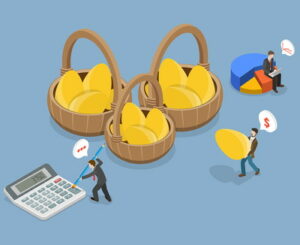 Diversification is a fundamental principle in decision-making, influencing various aspects of our lives, from consumer choices to investment strategies. This phenomenon suggests that individuals tend to demonstrate greater diversity when confronted with simultaneous choices compared to sequential ones. For example, if we are asked to choose a selection of ten chocolates simultaneously we tend to be more diverse in our choices than if choosing those chocolates one after another.
Diversification is a fundamental principle in decision-making, influencing various aspects of our lives, from consumer choices to investment strategies. This phenomenon suggests that individuals tend to demonstrate greater diversity when confronted with simultaneous choices compared to sequential ones. For example, if we are asked to choose a selection of ten chocolates simultaneously we tend to be more diverse in our choices than if choosing those chocolates one after another.
Diversification, whether in consumer choices or betting strategies, reflects a nuanced interplay between psychology and decision-making. The inclination towards diversity arises from a desire for novel experiences and a perceived sense of control.
Understanding these underlying mechanisms provides valuable insights into how individuals navigate choices in various contexts. By recognising the influence of presentation format and cognitive biases, we can make more informed decisions that align with our objectives and preferences.
In essence, diversification is a powerful tool that, when wielded with awareness, empowers individuals to navigate a world replete with choices and uncertainties to make the decisions that best suit their situation. In betting, diversification stops punters from putting too much money in one situation.
Diversification in Consumer Choices
 In scenarios where individuals are presented with an array of choices, such as selecting chocolates from a variety box, studies have shown that people exhibit a penchant for diversity. When tasked with choosing a fixed number of items from a diverse set, people often opt for a broader range of options, showcasing a preference for variety.
In scenarios where individuals are presented with an array of choices, such as selecting chocolates from a variety box, studies have shown that people exhibit a penchant for diversity. When tasked with choosing a fixed number of items from a diverse set, people often opt for a broader range of options, showcasing a preference for variety.
This inclination stems from the innate desire for novel experiences and the pleasure derived from exploring different flavours, textures and sensations. One of the primary drivers of diversification in consumer choices is the innate human desire for novelty and variety.
We are wired to seek out new experiences, flavours, textures and sensations. When presented with an assortment of options, individuals are more likely to choose a variety of items to satisfy this inherent need for novelty. The act of consuming or experiencing different things provides a form of sensory stimulation. This stimulation can lead to an increase in hedonic pleasure, which is the positive emotional response derived from a sensory experience. For example, in the case of selecting chocolates, trying a diverse range of flavours can lead to a heightened sense of pleasure.
Consuming the same item repeatedly can lead to a decrease in sensory pleasure due to a phenomenon known as sensory-specific satiety. This means that as we consume more of a particular item, our enjoyment or satisfaction with it diminishes. By diversifying our choices, we can delay or mitigate this satiation effect, allowing us to maintain a higher level of enjoyment.
A diverse array of options can create the perception of abundance, signalling to consumers that there are plenty of choices available. This perception can enhance the perceived value of the selection, as it implies that there is a wealth of options to explore.
Cognitive heuristics are mental shortcuts, or rules of thumb, that individuals use to simplify decision-making. One such heuristic that can contribute to diversification is the variety-seeking heuristic. This heuristic guides individuals to seek out diverse options in order to maximise their overall satisfaction or pleasure.
Cultural and social factors can also play a role in diversification tendencies. For instance, in cultures that highly value culinary exploration and diversity, individuals may be more inclined to select a wide range of dishes or flavours when they eat.
Meanwhile, the way that choices are presented can significantly influence diversification. Retailers and marketers often strategically arrange products to encourage exploration and diversity. For example, arranging products in visually appealing displays or offering sampler sets can entice consumers to try a broader range of options. This is something that bookmakers will often tap in to, advertising specific things in their shop windows that look like they provide punters with a wealth of choice, or putting different things on the homepage of their website.
Understanding the drivers behind diversification in consumer choices provides valuable insights for businesses and marketers, but can also be helpful for consumers. By recognising these tendencies, you can look out for the product offerings, marketing strategies and retail environments that are designed to cater to your natural inclination for variety and novelty, avoiding falling into the trap of betting on something simply because it has been made to appear like a diverse option rather than it actually being something that you know about and actively want to bet on.
Sequential v Simultaneous Decision-Making
 The manner in which choices are presented significantly influences the diversification phenomenon. When faced with sequential decisions, individuals tend to opt for familiar options or those that align with their initial preferences.
The manner in which choices are presented significantly influences the diversification phenomenon. When faced with sequential decisions, individuals tend to opt for familiar options or those that align with their initial preferences.
In contrast, simultaneous choices encourage exploration and experimentation, leading to a broader range of selections. This distinction highlights the impact of presentation format on decision outcomes. In sequential decision-making, individuals make choices one after another in a step-by-step manner.
This approach often leads to a more conservative selection process, as each decision is influenced by the preceding one. In betting, this might translate to a person considering one option at a time and being more cautious with their choices. For example, if someone is betting on a football match, they might first assess the likelihood of a home team win. If they are uncertain about this outcome, they might then consider the possibility of a draw, followed by an away team victory. This sequential process tends to lead to a more focused, but potentially more risk-averse, decision-making style.
In contrast, simultaneous decision-making involves evaluating all available options at once. This approach encourages a more exploratory and diversified selection process. When applied to betting, individuals are more likely to consider multiple outcomes simultaneously, which can lead to a broader range of bets. As an example, a person employing simultaneous decision-making might simultaneously assess the likelihood of a home team win, a draw and an away team victory. This approach often results in a more diverse selection, potentially including bets on multiple outcomes.
Sequential decision-making tends to be associated with lower perceived risk, as each decision is made in isolation. This may lead individuals to make safer bets or choose options they consider to be more likely. Simultaneous decision-making, on the other hand, can lead to a broader range of bets, potentially including riskier options. Simultaneous decision-making aligns more closely with a diversification strategy. By considering multiple outcomes at once, individuals spread their bets across different possibilities, which can provide a perceived sense of security.
This can be particularly evident in bets like Double Chance, where bettors cover multiple potential outcomes. Simultaneous decision-making can be influenced by cognitive biases such as the availability heuristic, where individuals give more weight to readily available information. This can lead to a preference for spreading bets across different outcomes, even if the underlying probabilities remain the same. The way betting options are presented can influence the decision-making process. For instance, if a betting platform presents options sequentially, individuals may be more inclined to consider each option in isolation. Conversely, a platform that displays options simultaneously may encourage a more diversified selection.
Understanding the interplay between sequential and simultaneous decision-making in betting can provide valuable insights for both bettors and bookmakers. Bettors can be aware of their decision-making style and consider how it may influence their betting choices, whilst bookmakers can design platforms and interfaces that cater to different decision-making preferences, ultimately enhancing the overall betting experience. Even merely knowing this can stop you from falling foul of your innate desire to look for more options and bet on things in a more diverse manner.
Diversification in Betting Behaviour

The concept of diversification extends beyond consumer choices and permeates into the realm of betting. In betting scenarios, individuals are inclined to invest more when the opportunity appears to be diversified.
A prime example is the Double Chance bet, where bettors back both the draw and the away team, say, believing it to be a more diversified approach. This perception is rooted in the notion of spreading risk and increasing the perceived likelihood of a favourable outcome. By offering a punter more choice, the bookmaker makes it seem like they’re making a more diverse selection.
One of the primary reasons individuals engage in diversification in betting is to mitigate risk. By placing bets on multiple outcomes, bettors aim to spread their exposure and reduce the potential for significant losses. This approach is akin to the principle of diversification in investment portfolios, whereby spreading investments across different assets aims to minimise overall risk. Diversification creates the illusion of an increased chance of winning. When individuals bet on multiple outcomes, they feel as though they have covered more ground and are more likely to be correct in at least one of their predictions.
Of course, this perception can provide a sense of security and confidence in one’s betting strategy even when it doesn’t actually exist. Such diversification can provide a level of psychological comfort to bettors. Knowing that they have covered multiple potential outcomes can reduce anxiety or apprehension associated with the uncertainty of betting. This sense of comfort can lead to a more positive overall betting experience. Spread bets, such as Double Chance wagers, are a common example of diversification in betting that offers such comfort.
In a Double Chance bet, a bettor wagers on two of the three possible outcomes in a match: Home Win or Draw, Away Win or Draw, Home Win or Away Win. This type of bet is appealing because it covers more scenarios, providing a perceived sense of safety. Similar to the illusion of control in decision-making, diversification in betting provides a feeling of control over the outcome. Bettors believe that they have taken proactive measures to increase their chances of winning, even though the underlying probabilities remain unchanged. It is an illusion of control rather than control itself.
The way that betting options are presented on platforms can influence diversification tendencies. Platforms that prominently display multiple betting options may encourage bettors to consider a wider range of outcomes, leading to a more diversified betting strategy. Whilst diversification can provide a sense of security, it’s important for bettors to recognise that it may also dilute potential returns. Spreading bets across multiple outcomes can lead to smaller individual payouts if successful. Therefore, bettors must strike a balance between risk mitigation and the potential for higher returns.
It is crucial for bettors to be aware that diversification does not alter the actual probabilities of outcomes. Although it may reduce short-term risk, in the long run, bettors should base their decisions on accurate assessments of the true probabilities associated with each outcome.
Understanding the dynamics of diversification in betting behaviour empowers both bettors and bookmakers. Bettors can make more informed decisions about their betting strategies, whilst bookies can design platforms and offer bet types that cater to the preferences and tendencies of their target audience.
The Illusion Of Control
 The Illusion of Control in the context of gambling refers to the cognitive bias where individuals believe they have more influence or control over the outcome of a bet than they actually do. This perception can lead to behaviours like diversification, where people engage in strategies to spread their bets in an attempt to increase their chances of winning.
The Illusion of Control in the context of gambling refers to the cognitive bias where individuals believe they have more influence or control over the outcome of a bet than they actually do. This perception can lead to behaviours like diversification, where people engage in strategies to spread their bets in an attempt to increase their chances of winning.
The illusion of control stems from the human tendency to seek a sense of control over uncertain situations. In gambling, individuals may believe that certain actions or strategies they employ can influence the outcome, even when the outcome is inherently random or based on chance.
People often develop superstitions or rituals in gambling as a way to exert perceived control. These can range from specific ways of placing bets to wearing certain items of clothing. These rituals provide a sense of agency, even though they have no real impact on the outcome. Allowing individuals to make choices or actively participate in the betting process can enhance the illusion of control. For example, in games where bettors select their numbers or make decisions during play, they may feel like their choices are significant in determining the outcome.
Some forms of gambling, such as poker or sports betting, involve an element of skill. In these cases, individuals may genuinely have some influence over the outcome through their decisions and knowledge. However, even in games of skill, chance can play a significant role.
When individuals experience a win, they often attribute it to their own skill or strategy, reinforcing the belief in their ability to control the outcome. Conversely, losses may be attributed to external factors, luck or perceived mistakes in execution. Positive feedback, such as occasional wins, can reinforce the belief in one’s control over the outcome.
These wins can be seen as validation for the strategies or choices made, further solidifying the illusion of control. Diversification is one way individuals attempt to exert control over gambling outcomes. By spreading their bets, they believe they are increasing their chances of winning, even though the underlying probabilities remain unchanged.
This strategy provides a sense of security and control, despite the inherently uncertain nature of gambling. Diversification can also serve as a risk perception management strategy. By diversifying their bets, individuals feel they are taking proactive steps to manage risk, even though the actual level of risk may not change significantly.
Recognising the illusion of control, especially around the influence of diversity, is crucial for promoting responsible gambling behaviour. Understanding that outcomes are largely determined by chance can help individuals make more informed and rational decisions about their gambling activities.
Ultimately, a nuanced understanding of diversification enhances the overall betting experience. The preference for bets like Double Chance can be attributed to the illusion of control. By diversifying their bets, individuals feel as though they have a greater influence over the outcome. However, in reality, this perception does not necessarily translate into a higher probability of winning. The underlying probabilities remain unchanged, underscoring the cognitive bias that drives such betting behaviours in bettors that have fallen into the trap of diversification.
